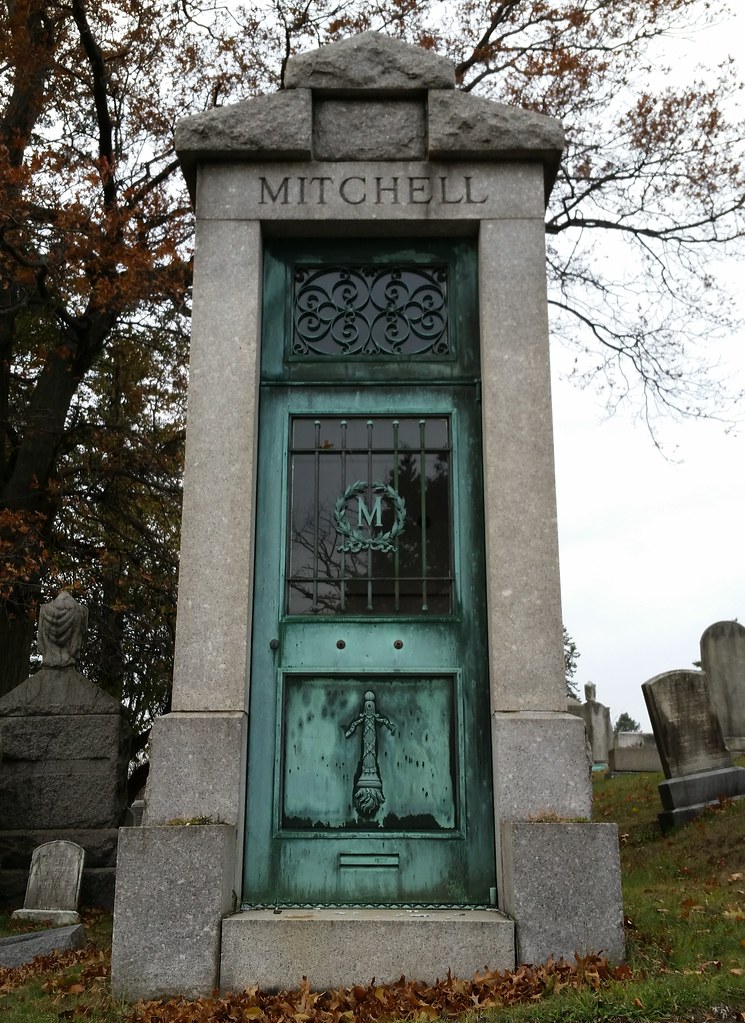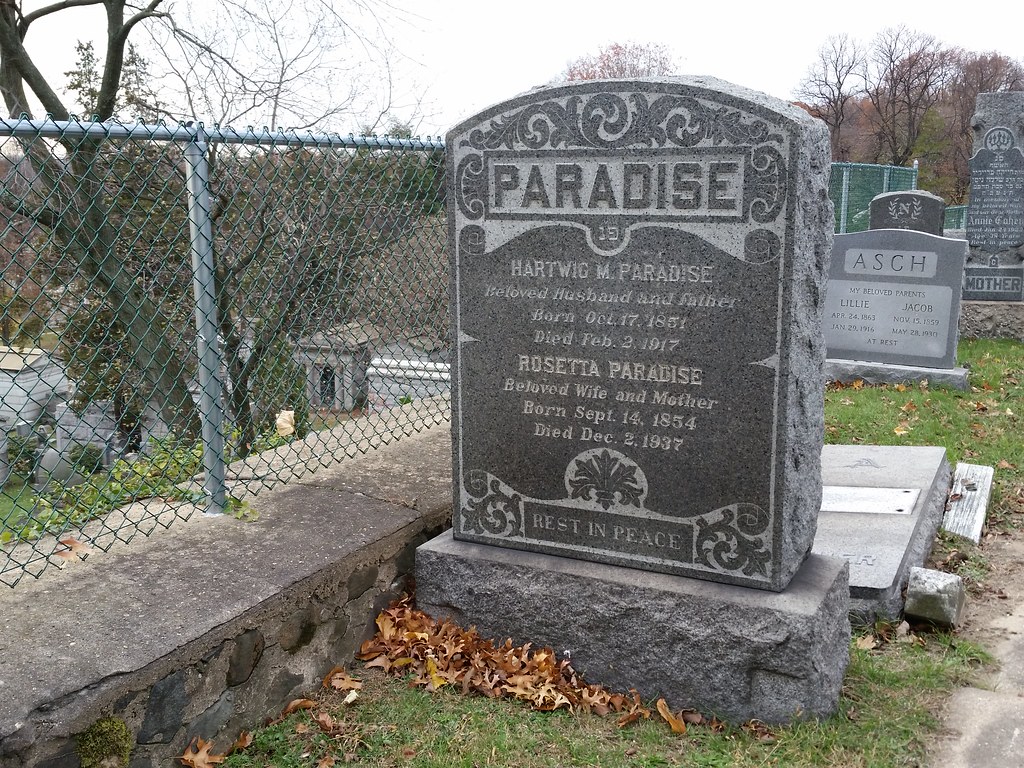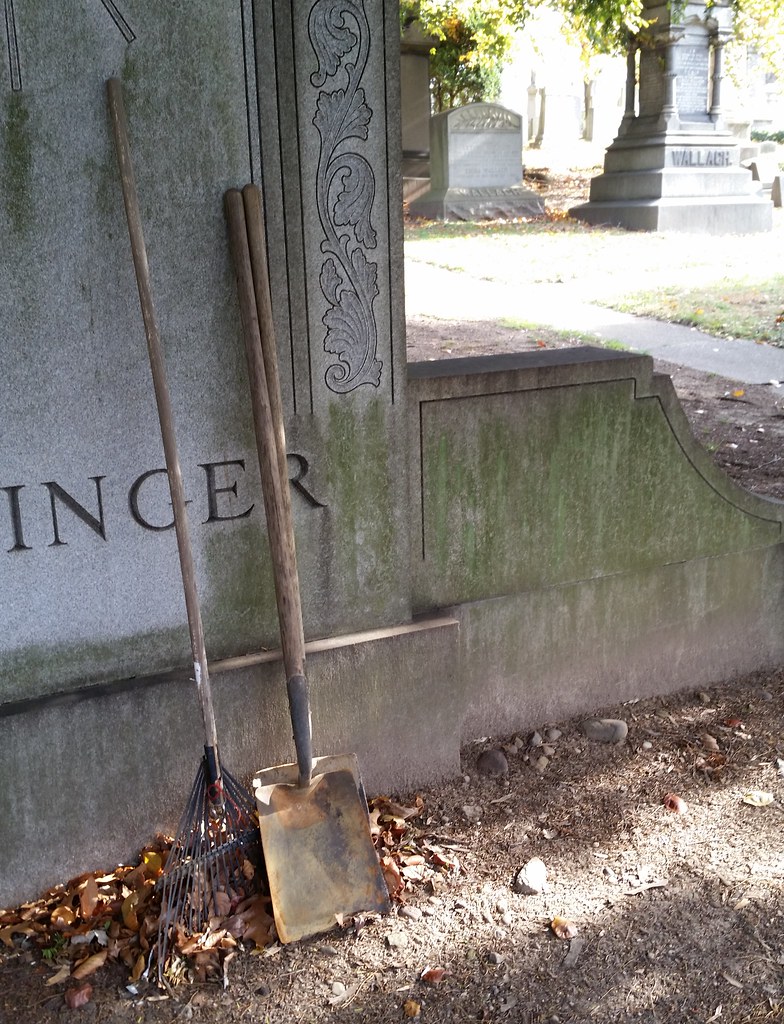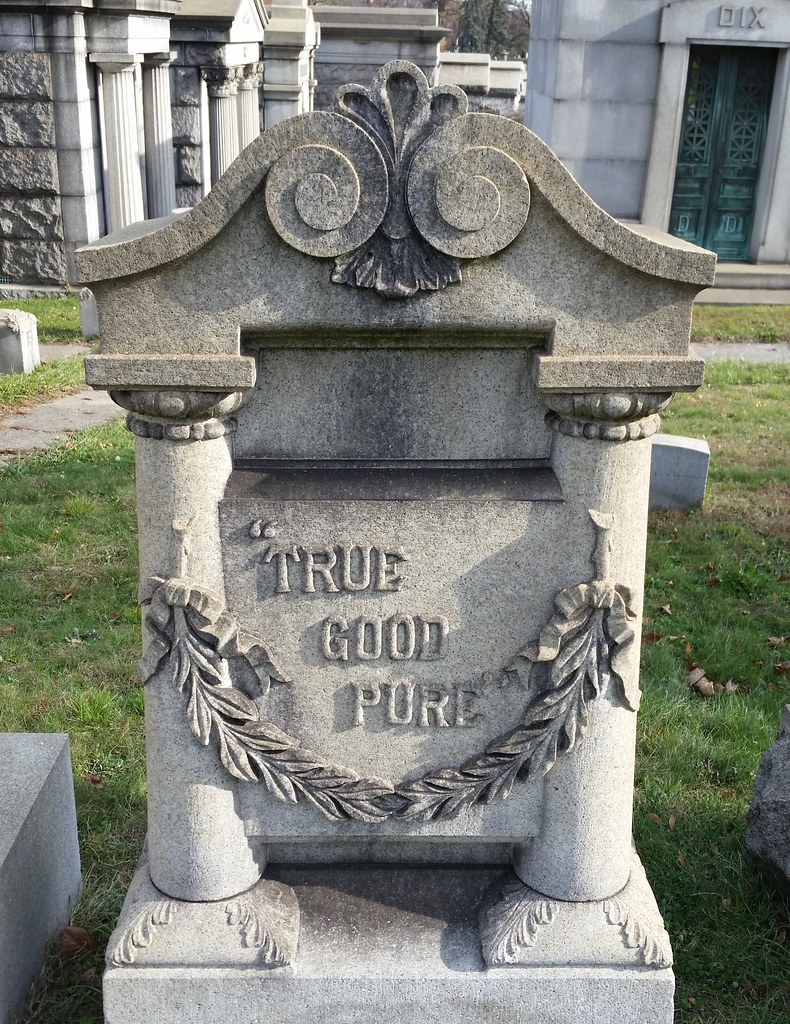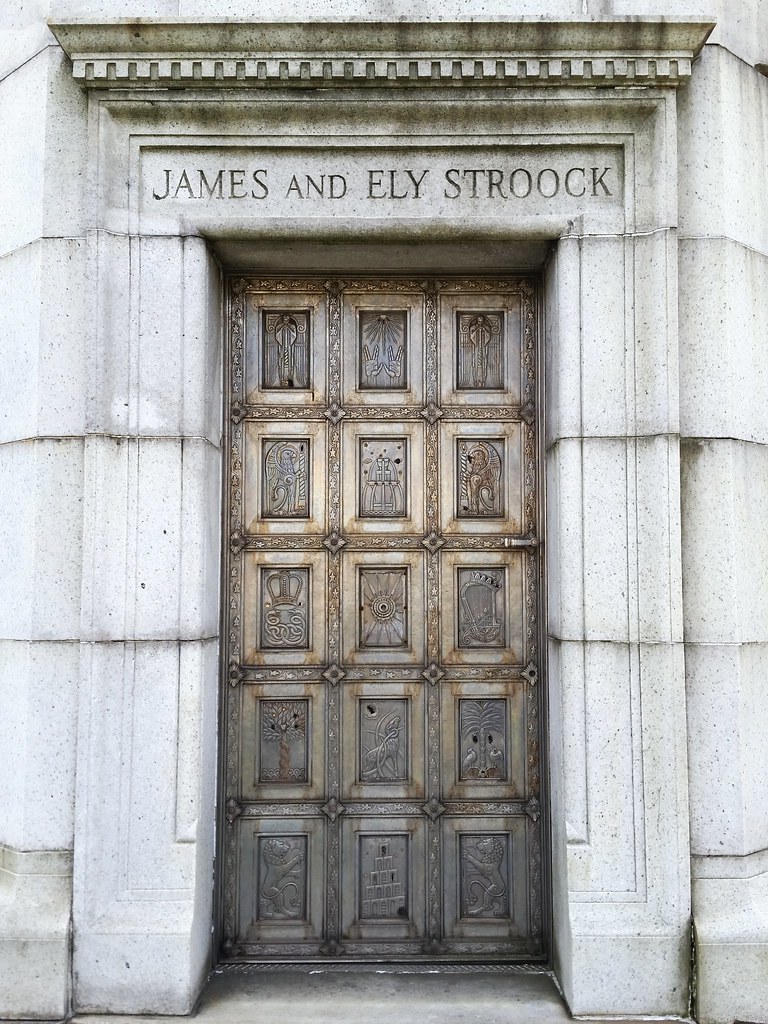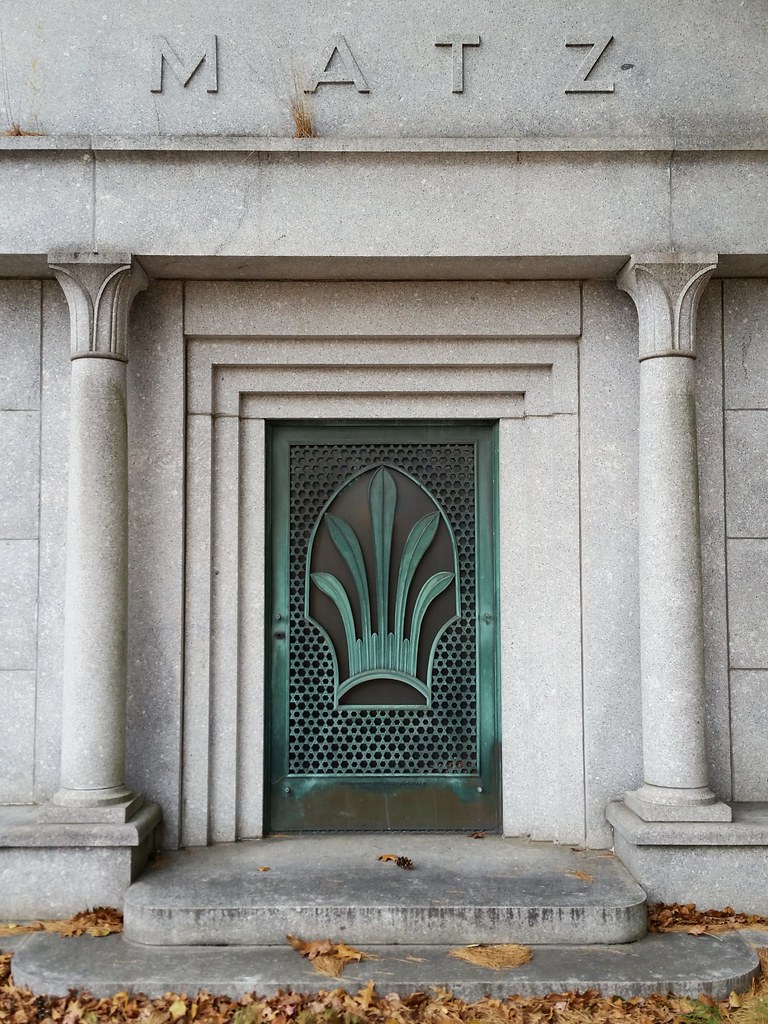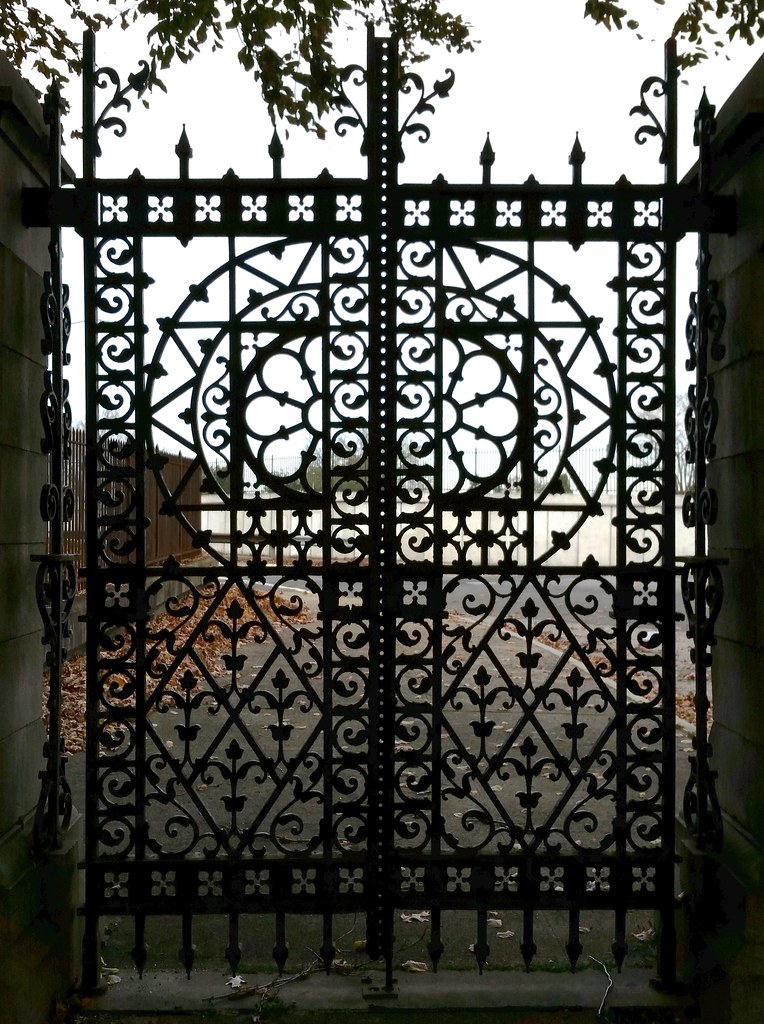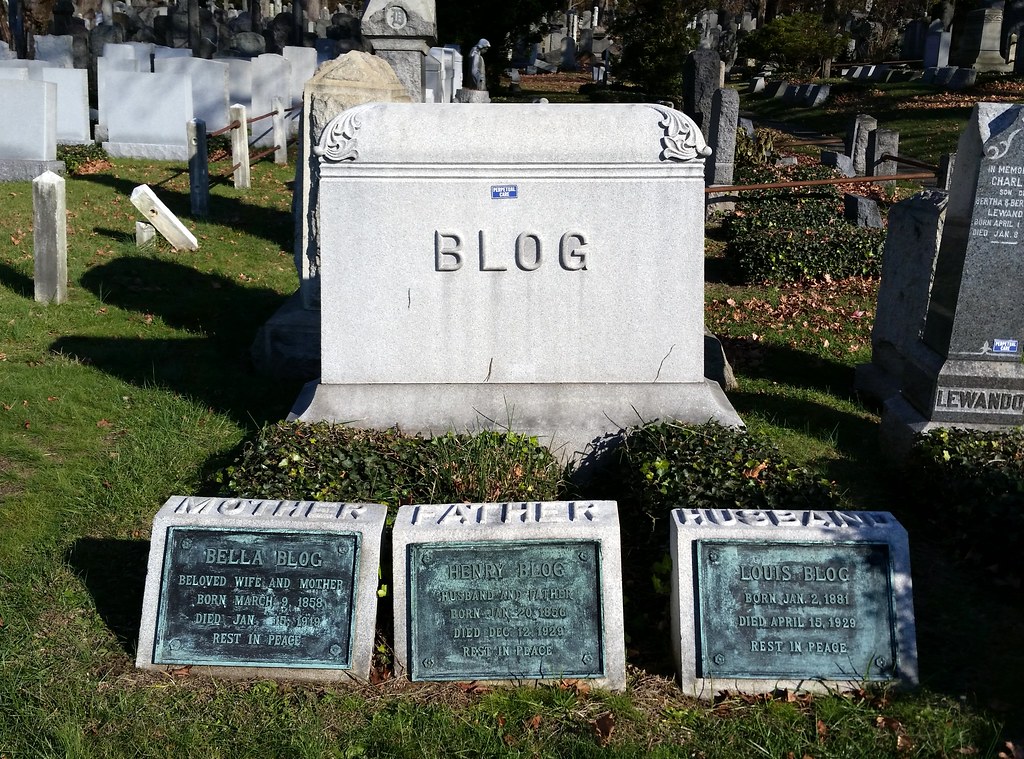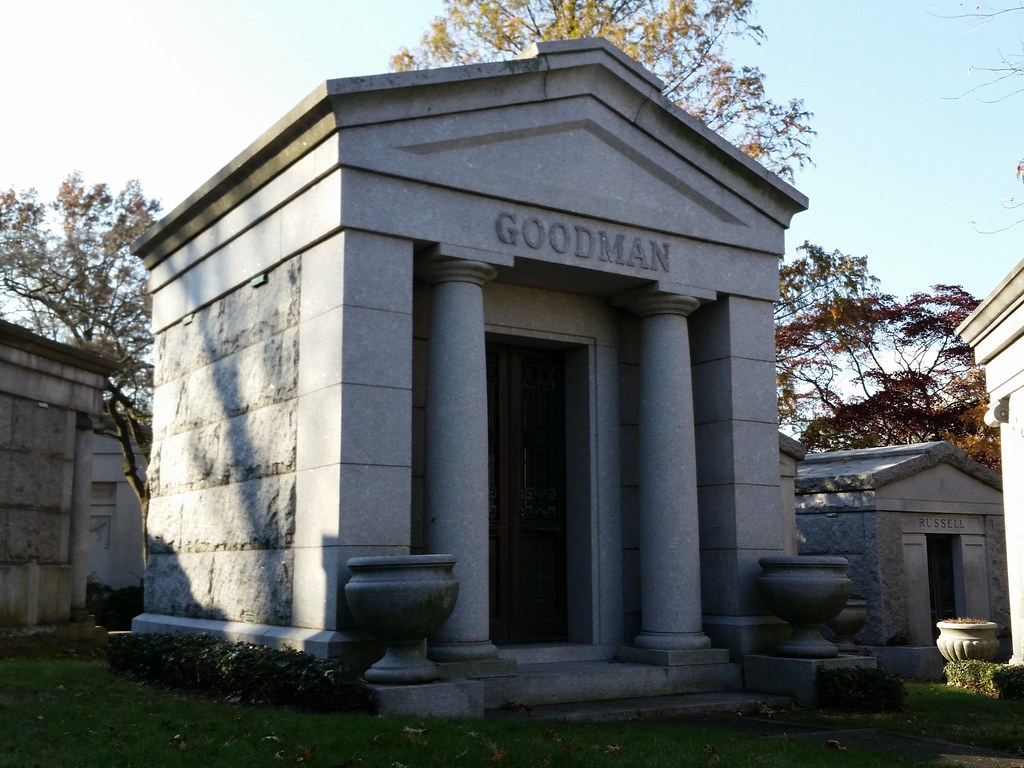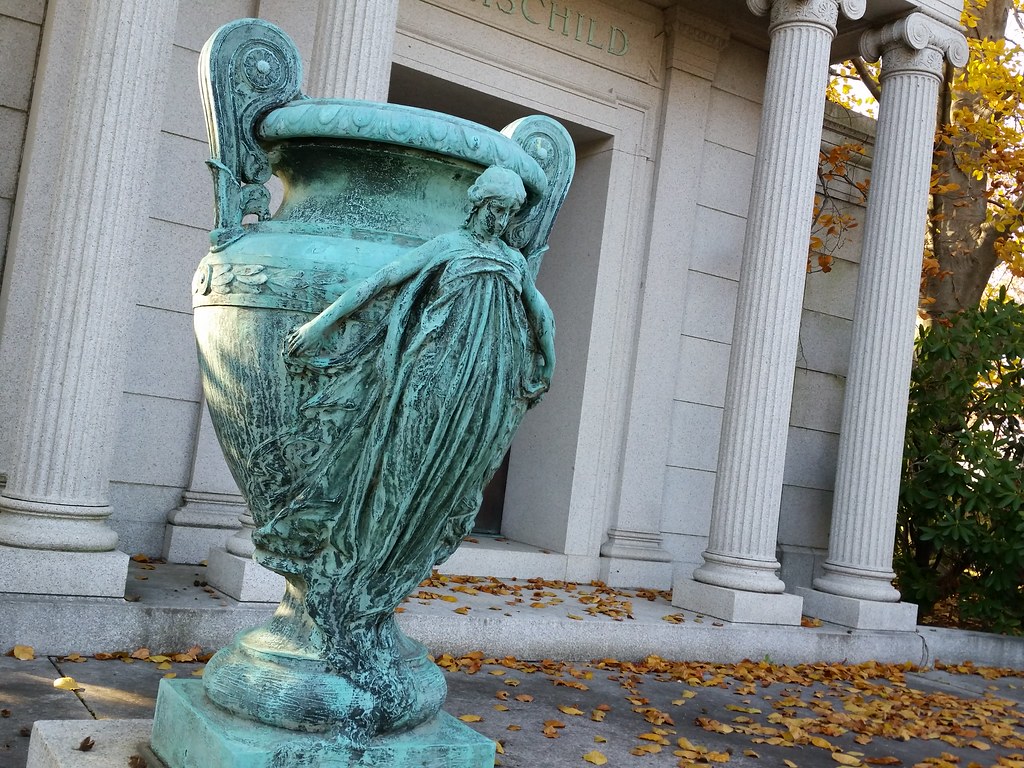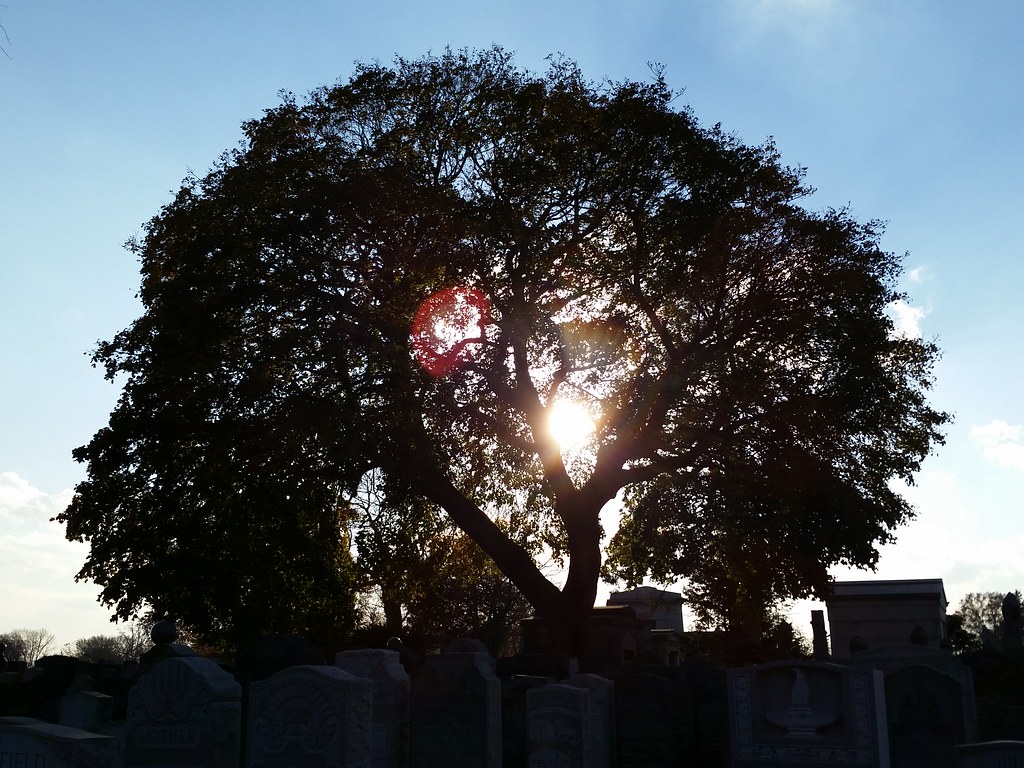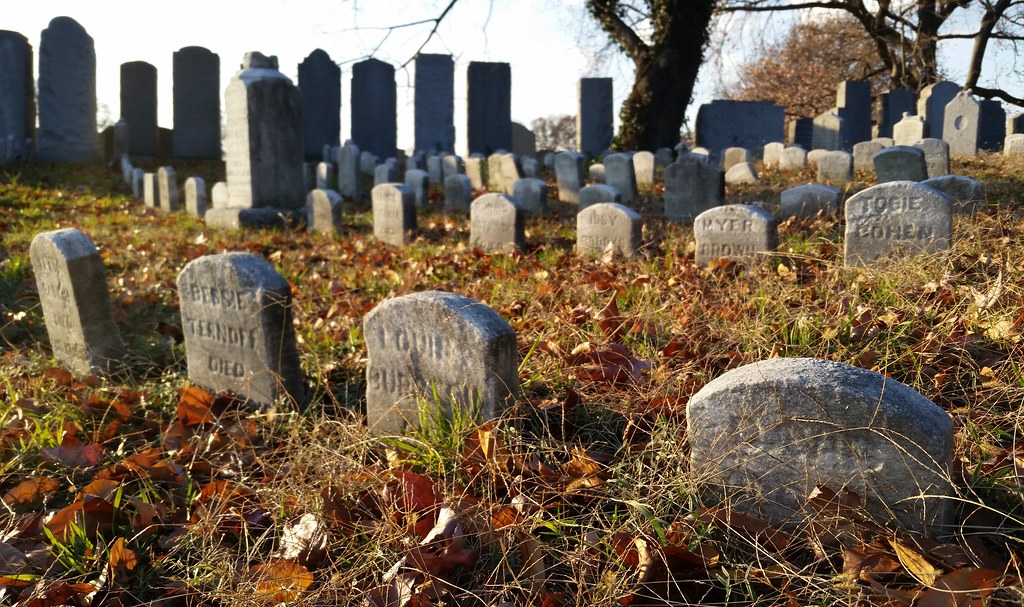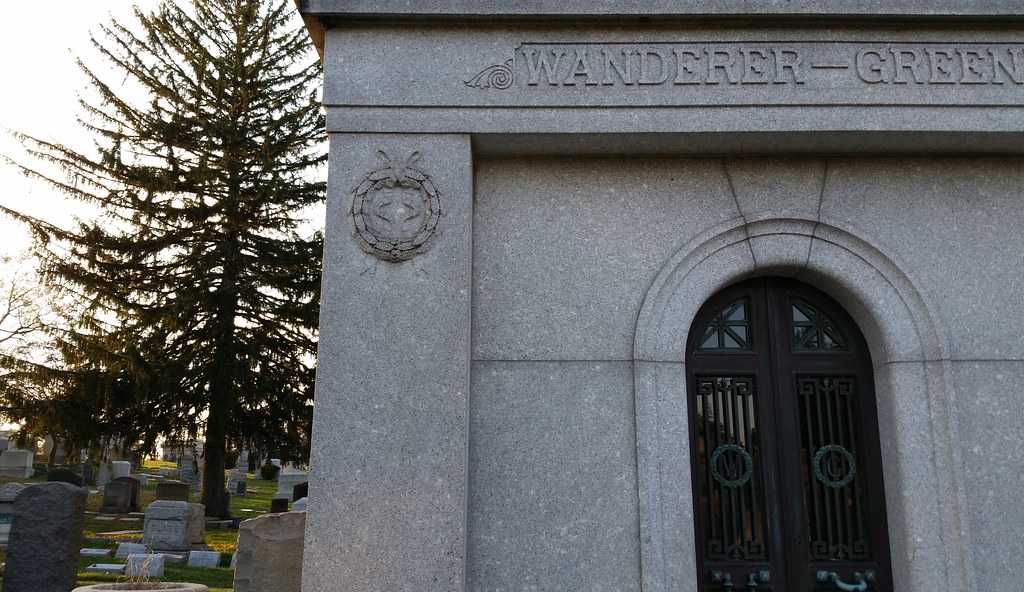
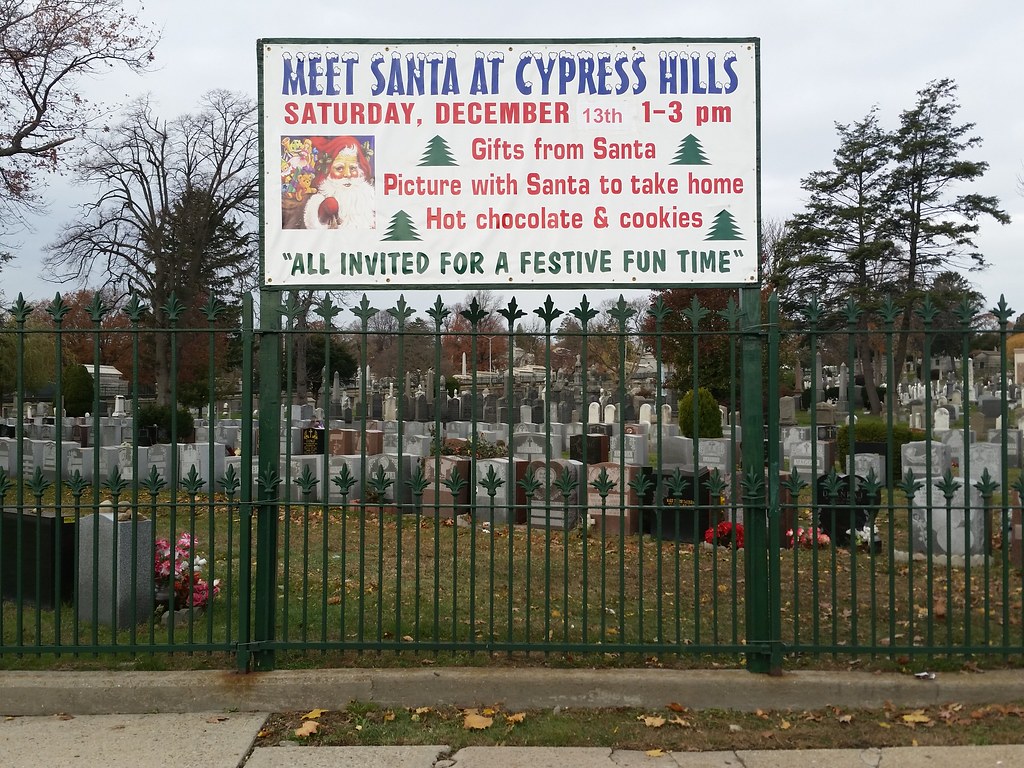
at Cypress Hills? I love a good cemetery as much as anybody, but this seems like a bizarre place to take the kids for a Santa meet-and-greet.
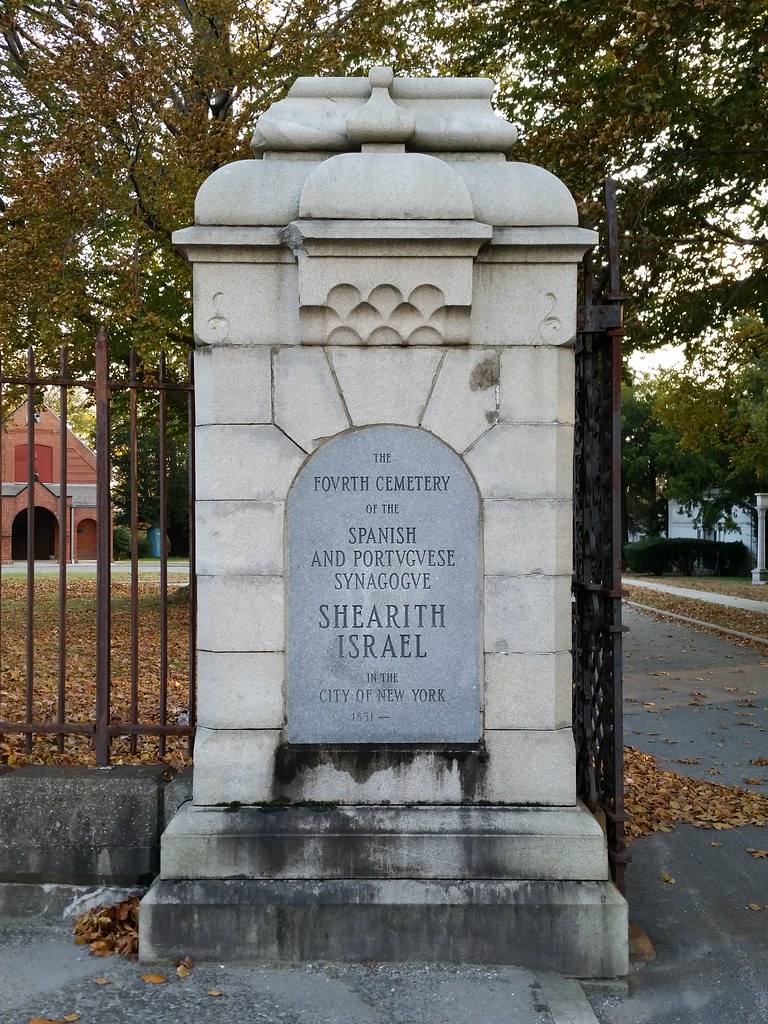
Beth Olom consists of burial areas for three different synagogues: Shearith Israel, B’nai Jeshurun, and Shaaray Tefila. Shearith Israel, founded in 1654, was the first Jewish congregation in North America and the only one in New York City until 1825, when some of its members left to form B’nai Jeshurun. Shaaray Tefila split off from B’nai Jeshurun in 1845.
As you can see above, the Shearith Israel portion of Beth Olom is known as the synagogue's fourth cemetery. We've already seen its first, second, and third cemeteries in Manhattan. (The congregation may have had an earlier cemetery that predated even the "first" one: in 1656, the city's Jewish community was granted permission to use "a little hook of land situate outside of this city for a burial place", but there is no definite record of this burial ground's establishment or location.)
In what I would imagine was just a weird coincidence, I once walked past this cemetery — the final resting place of Emma Lazarus — and found that someone had left a large statue of the beggar Lazarus and two of his canine companions standing outside the gate.

From atop the Harbor Hill Moraine at the edge of Beth Olom Cemetery, I'm looking down at Salem Fields Cemetery and out onto the outwash plain of southern Brooklyn and Queens.
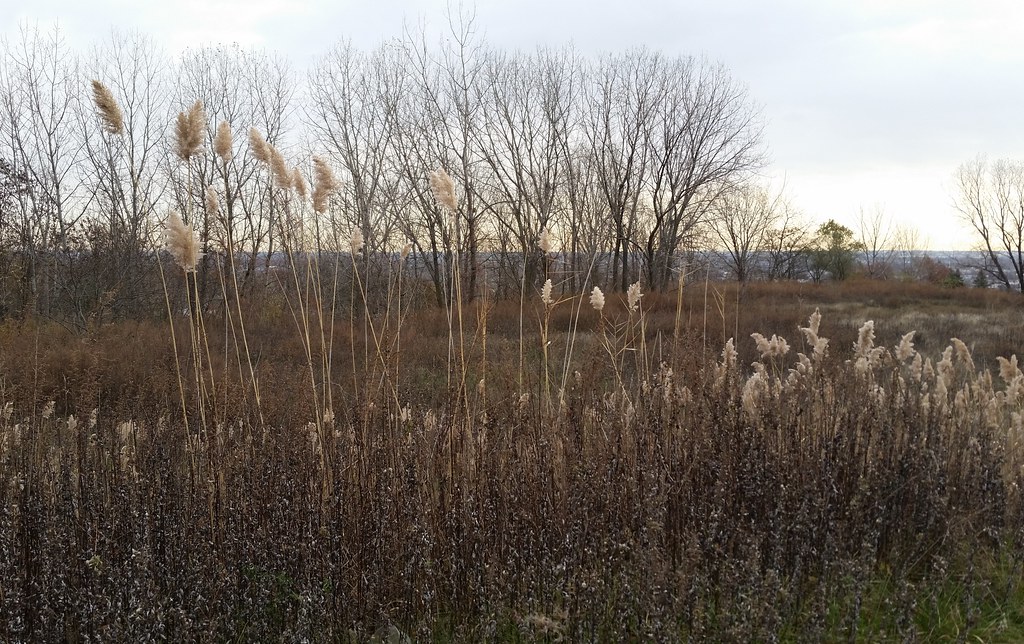
This steep-sided, flat-topped, unnatural-looking hill rises abruptly just beyond the western edge of Beth Olom Cemetery. Standing above the surrounding sea of burial grounds and the neighboring Ridgewood Reservoir, it's a very curious sight — the only piece of land in the vicinity that's not part of a cemetery or park.
It turns out that for about half a century, starting around 1877, this property was home to a privately run recreation area known as Cypress Hills Park. It was owned by the Banzer family but had different proprietors over the years, and so was also at times called Banzer's, Wissel's, Bookman's, Richter's, or Gerken's Park. A large U-shaped pond, used by boaters in the summer and ice skaters in the winter, was the dominant feature of the site (1924 aerial view), which also contained, by 1891, a pavilion, a bandstand, a dining room, four bowling alleys, and some popular shooting ranges where "some of the best rifle shots in the United States . . . [had] their regular practice days". (You can see old photos of the place here; scroll down about halfway.) The park's days came to an end around 1928, when the Banzers sold the land to its present owner, Temple Emanu-El, the Jewish congregation that also owns the adjacent Salem Fields Cemetery.
The pond was filled in sometime before 1951, although at least part of it still existed in 1937 when a 13-year-old boy drowned in it, an incident that prompted the boy's father to sue the synagogue. Over the years, it appears that Emanu-El used the site as a dumping ground for dirt and rocks — including, perhaps, some excavated material from the cemetery and/or other nearby cemeteries? — forming the hill that now stands here. An aerial view from 1996 shows a largely barren landscape with a path running up the hill, presumably for trucks and earth-moving equipment, while subsequent images from the past decade (2006, 2008, 2010, 2012) show trees springing up and the dirt paths gradually becoming overgrown.

The artificial hill on the former site of Banzer's Cypress Hills Park stands high above even the upper section of Cypress Hills National Cemetery.
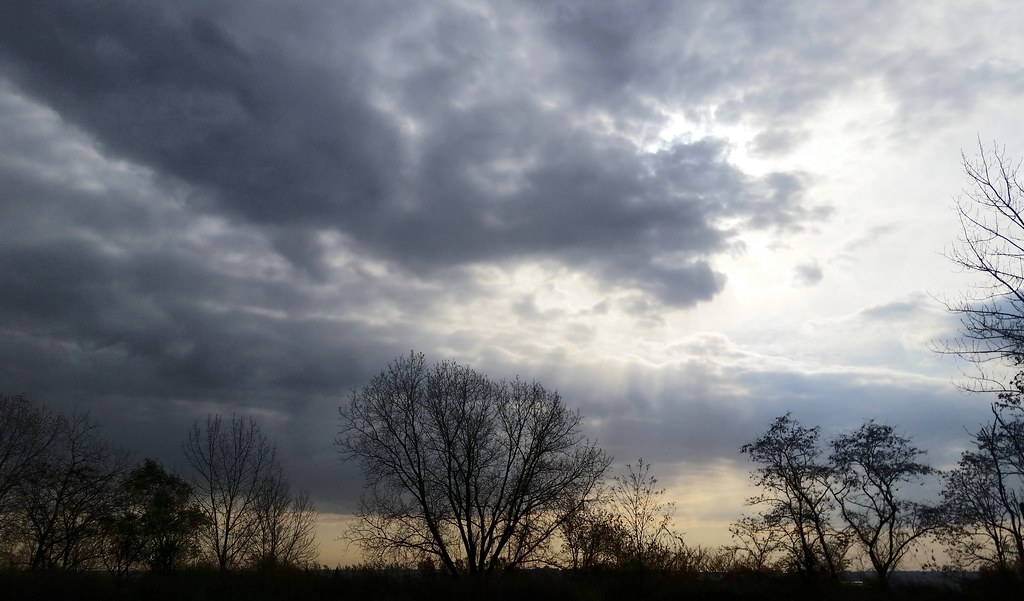
Here's one more shot from the artificial hill that stands on the former site of Banzer's Cypress Hills Park. While researching the park, I discovered that there used to be a Brooklyn neighborhood called Picklesville in the area of East Williamsburg/Bushwick. Some highlights from my subsequent quest for information about Picklesville:
- A Brooklyn Daily Eagle article from May 30, 1936, entitled "A Lot of Bologna, Indeed, Comes Out of Long Island in the Course of a Year—and the Whole World Eats It, Thick or Thin", part of a larger tribute to the industries of Long Island:
Shortly before the turn of the century, the vicinity of Morgan Ave. and Rock St. was decidedly a rural section. The inhabitants who were mostly of German descent lived in trim bungalows along the tree-lined, level dirt streets. The chief activity of these German farmers was the raising of pickles for nearby metropolitan market, and consequently the neighborhood earned the appropriate if inelegant title of "Picklesville."
- An NY Times article from October 5, 1883, entitled "Two Irate Picklesvillians — True Love Pursuing the Traditional Erratic Course":
Far over in the wilds of Brooklyn, away from the strife and turmoil of the city, is the little suburb of Picklesville . . . So rural is this place that no cars run through its quiet streets, beer saloons are infrequent, and the belated Picklesvillian going home from his business in the city at 9 o'clock at night discovers no signs of life in the deserted thoroughfares, save as the night-winds convey to his ears the tuneful breathing of the sleeping inhabitants. Even into so quiet a community as this, however, trouble may enter and dissensions lead to seemly squabbles. Within a week a scandal has arisen which has convulsed the entire district of Picklesville.
- A Brooklyn Daily Eagle article from February 2, 1890, entitled "Dogs of War Let Loose — Hostilities Renewed Between Picklesville and Elm Street":
The casus belli is a question of territorial rights, the boys of Picklesville claiming that Picklesville includes the easterly side of Knickerbocker avenue and the Elm street men claiming that both sides of the street are included in their domain. The armies yesterday, equally matched, numbered about two thousand; the Picklesville forces, two divisions, under command of General John Seid, of 102 Central avenue, aged 17, and the Elm street forces, two divisions, under General Charles Engelhoffer, of 195 Ellery street, aged 11 years. Johnny Schneider, aged 13, commanded the right wing of the Picklesville forces and went early into action, or was rather drawn into it by the capture of all his pickets by Lieutenant Colonel Epaminondas Schwakhammer, aged 13, in command of the Elm street band of skirmishers. . . . General Seid, seeing that Schneider's command was in danger of being cut off and attacked in detail, dispatched his aide de camp, Diedrich Finnegan, with an order to fall back on the sand bank known as the Eagle's Nest, back of the Manhattan Avenue Railroad, beyond Irving avenue. On his way the aide de camp was struck with a tomato can, knocked down, taken prisoner, and the order fell into the hands of the enemy. The result foreseen by General Seid then took place. Schneider's command was cut off and most of them, after a terrible resistance, laid down their arms. While Seid with the main body of his forces was pressing on the cry of "Police" was raised, and the form of Officer John Ruoff looming up in the distance like Gulliver, the Liliputian [sic] armies became instantly a rabble rout.
- A Brooklyn Daily Eagle article from December 22, 1890, entitled "War on the City Frontier — It Is Brought to a Close by the Intervention of a Third Power":
The war has been a protracted one, dating back over a year, the casus belli being the north side of Knickerbocker avenue . . . The contending forces came within sight of each other on Knickerbocker avenue, between Starr street and DeKalb avenue. The Picklesvillers, halting, were addressed by General Sauerbrod from the roof of a grocery coal bin. He said:
"Men of Picklesville—I do not expect that words from me can impart valor to anyone who lacks it. The enemy is before us, but let the recollections of memorable deeds done by men of Picklesville in the past stimulate you to the achievement of greater things this day. Soldiers, from the cupola of yonder brewery twenty years look down upon you." . . .
[After several of the boys were arrested and locked up for the night,] Justice Goetting this morning seemed at first determined to send the prisoners to the Fortress of Refuge till they were 21 years old, but finally let them off with a fine of $5 each.

The first Jewish commodore in the US Navy, Uriah Phillips Levy was a key figure in the push to abolish flogging — or "the barbarous practice of corporal punishment", as his grave monument puts it — in the Navy. (He was, however, once court-martialed for "scandalous and cruel conduct" for his implementation of an alternative punishment for a teenage boy on his ship who "was charged with mimicking an officer of the ship. Unwilling to flog the boy, Levy ordered him tied to a gun with his trousers lowered. A small quantity of tar, variously described as the size of a silver dollar to the size of a man's head, was applied with oakum to his buttocks along with some parrot feathers.")
Levy is best remembered for his role in saving Thomas Jefferson's Monticello. When he arranged to purchase the property from James Turner Barclay in 1834, eight years after Jefferson's death, the place was in a sorry state. Jefferson had been unable to afford upkeep on the house in his later years, and Barclay, a local druggist with "a hare-brained scheme of turning Monticello into a silkworm farm", allowed things to fall further into decline.
A great admirer of Jefferson*, Levy gathered "a small army" of hired workers and slaves to bring the house back to its former glory. In his will, he offered the property to the federal government for use as a farm school for children of deceased naval warrant officers. Shortly before his death in 1862, however, Monticello was seized by the Confederacy. The federal government did not accept Levy's bequest of the property, and his will was declared invalid in 1865, leaving the place in a state of legal limbo after the Civil War.
By the time Uriah's nephew Jefferson Monroe Levy gained control of the property in 1879 following a lengthy period of litigation, it had once again slid into disrepair. It was being used as a working farm, with grain stored in the house and cattle herded into the basement during winter. Like his uncle before him, Jefferson Levy began fixing up the house and grounds, with the intent of restoring them "to the original plans and style". In 1923, the year before his death, he sold Monticello to the Thomas Jefferson Memorial Foundation (now the Thomas Jefferson Foundation), which has maintained it and kept it open to the public ever since.
* In 1834, Uriah Levy presented Congress with a bronze statue of Thomas Jefferson he had commissioned. It was the first full-length portrait statue to be placed in the US Capitol, and is the only statue in the Capitol donated by an individual citizen. Levy gave the plaster model used to create the statue to the City of New York; it currently stands in the chamber of the City Council, where its presence has long been decried by former Councilman and current State Assemblyman Charles Barron, who has described Jefferson as a "white, slave-owning pedophile".
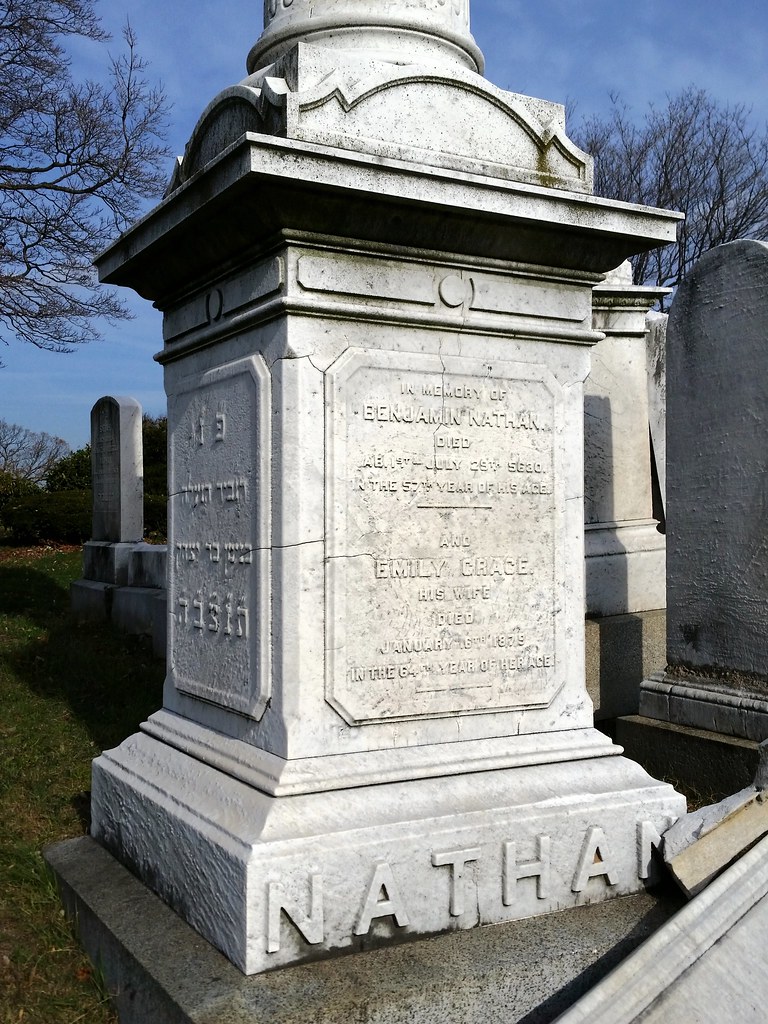
The eponymous uncle of Benjamin Nathan Cardozo was the victim of a sensational, and still unsolved, murder — an assault that was "more atrocious and more shocking than any recent crime" and that left him "marred and mutilated out of semblance to his kind", according to an NY Times article from July 30, 1870, the day after he was killed.
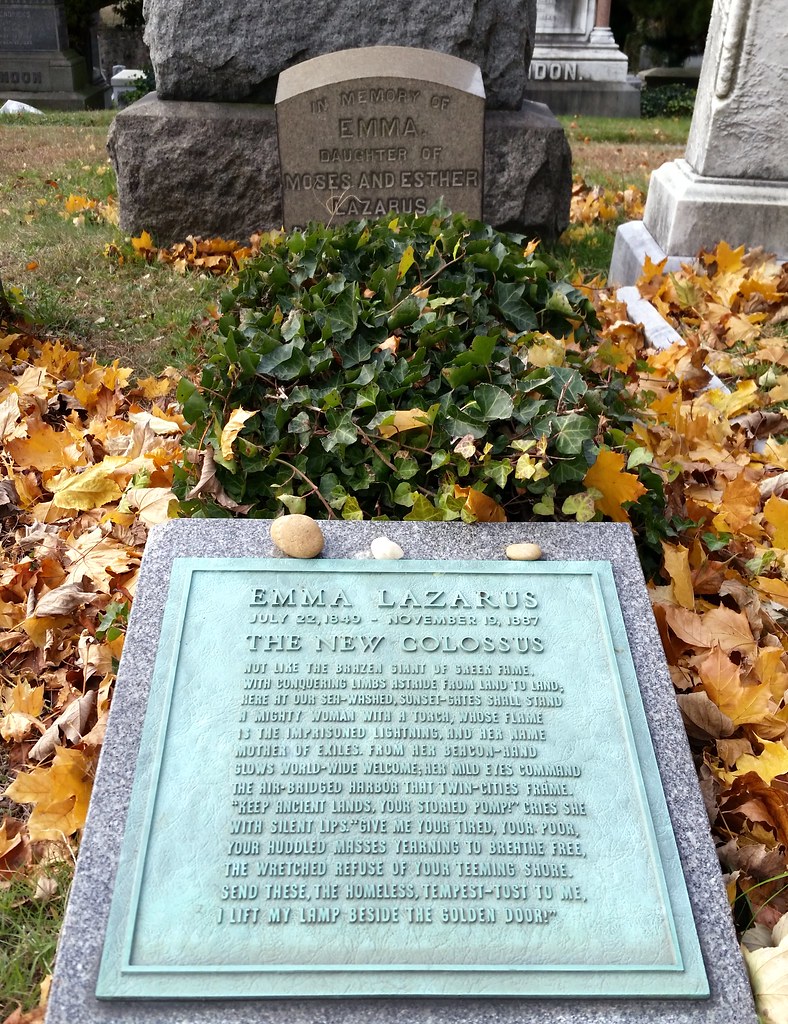
Emma Lazarus (a first cousin of Benjamin Cardozo) was the author of "The New Colossus", the famous poem found inside the pedestal of the Statue of Liberty, which reads in part:
"Keep, ancient lands, your storied pomp!" cries she(The comma after "Keep" is missing from the versions of the poem on Liberty Island and at Ms. Lazarus's grave.)
With silent lips. "Give me your tired, your poor,
Your huddled masses yearning to breathe free,
The wretched refuse of your teeming shore.
Send these, the homeless, tempest-tost to me,
I lift my lamp beside the golden door!"
The statue originally had nothing to do with immigration, however. It was the verses penned by Ms. Lazarus that eventually fixed it in the popular imagination as a beacon welcoming the tired and the poor of foreign lands to New York Harbor.
From the NY Times:
When the Goddess of Liberty was given to the United States, its donor's agenda was to burnish France's republican roots after the oppressive reign of Napoleon III and to celebrate the two nations' commitment to the principles of liberty.
The only immigrants mentioned at the dedication in 1886 were the "illustrious descendants of the French nobility" who fought on behalf of the United States against Britain during the American Revolution.
But it was the words of a fourth-generation American whose father was a wealthy sugar refiner and whose great-great-uncle welcomed George Washington to Newport, R.I., that almost single-handedly transformed the monumental statue in New York Harbor into the "Mother of Exiles" that would symbolically beckon generations of immigrants. . . .
Lazarus's "New Colossus," with its memorable appeal to "give me your tired, your poor," was commissioned for a fund-raising campaign by artists and writers to pay for the statue's pedestal.
But while the poem was critically acclaimed — the poet James Russell Lowell wrote that he liked it "much better than I like the Statue itself" because it "gives its subject a raison d'être which it wanted before quite as much as it wants a pedestal" — it was not even mentioned at the dedication ceremony.
Finally in 1903, after relentless lobbying by a friend of Lazarus who was descended from Alexander Hamilton, himself an immigrant, it was "affixed to the pedestal as an ex post facto inscription," the art historian Marvin Trachtenberg wrote.
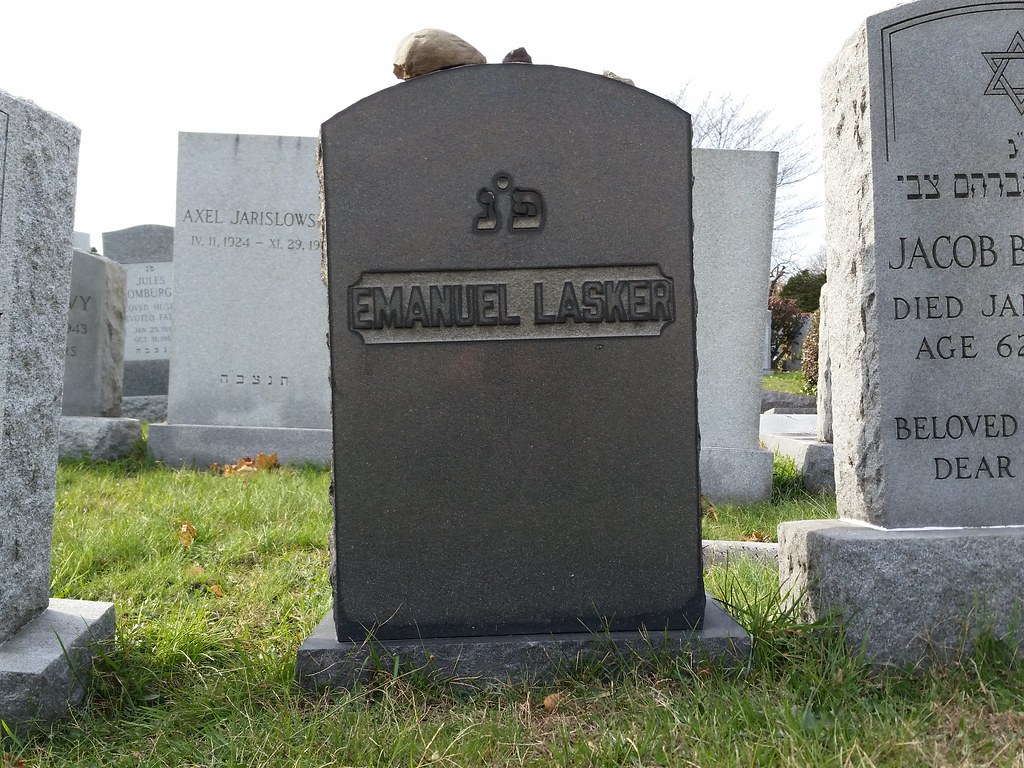
Emanuel Lasker was one of the greatest chess players of all time, winning the world chess championship from William Steinitz in 1894 and holding onto it until 1921.
(As we learned when we saw Steinitz's grave in the Evergreens Cemetery, his 1894 loss to Lasker was the beginning of his mental troubles, at least according to the narrative of his 1900 NY Times obituary, and his defeat in a rematch a couple of years later triggered his rapid decline into insanity.)

We've left Beth Olom Cemetery, crossed the Jackie Robinson Parkway, and entered Hungarian Union Field Cemetery, which is now part of Mount Carmel Cemetery.

The quotation on this gravestone comes from Mark Antony's tribute to Brutus at the end of Shakespeare's Julius Caesar.
(Now we're in Union Field Cemetery, another of the 17 cemeteries clustered together near the middle of the Brooklyn-Queens border.)
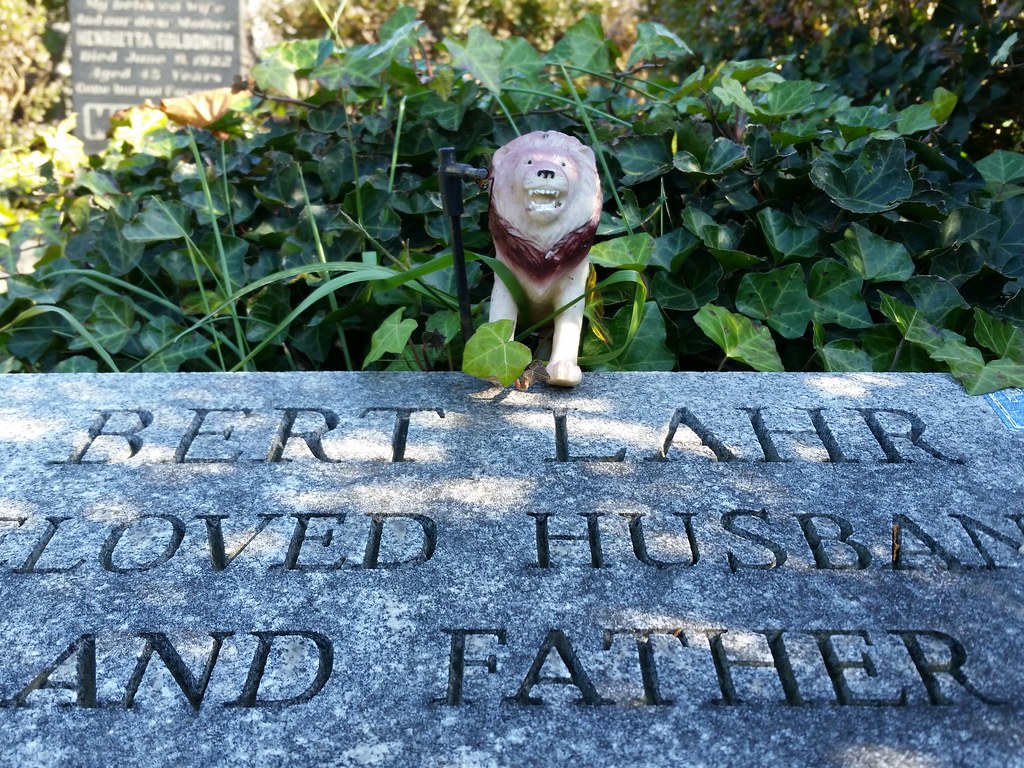
Bert Lahr is best known for playing the Cowardly Lion (video) in The Wizard of Oz, but he was also associated with another big cat: Hanna-Barbera's Snagglepuss, a seeming rip-off of Lahr whose famous catch phrase — "Heavens to Murgatroyd!" (video) — was first spoken by Lahr in the 1944 movie Meet the People.

According to historian Robert Rockaway:
Best known, perhaps, as the man who allegedly "fixed" the 1919 World Series between the Chicago White Sox and Cincinnati Reds, Rothstein is recognized as the pioneer big businessman of organized crime in the United States. A man of prodigious energy, imagination and intellect, he transformed American crime from petty larceny into big business. One social historian described him as "the J.P. Morgan of the underworld; its banker and master of strategy." . . .
During the 1920s, Rothstein put together the largest gambling and bookmaking empire in the nation, masterminded a million-dollar stolen bond business, and controlled most of New York's gangs, as well as that city's traffic in narcotics, bootlegging and gambling. . . .
With the coming of Prohibition, Rothstein's business empire developed another dimension — bootlegging. Rothstein laid the foundation for the enormous profits of Prohibition by creating an organization to buy high quality liquor by the shipload in England and distribute it to buyers in the United States. This idea caught on and soon others were engaged in the same enterprise. . . .
He next turned his talents to narcotics smuggling which, until he became involved, had been unorganized. Rothstein converted the racket into a businesslike machine by sending buyers overseas to Europe and the Far East, and by controlling the purchasing operation in the United States. . . . By 1926, Rothstein was allegedly the financial overlord of the foreign narcotics traffic in America.

We've now moved on to Machpelah Cemetery (where, coincidentally, Joseph Banzer of Banzer's Cypress Hills Park was for years the superintendent). The "daunting, abandoned building that was once the cemetery office", seen in this video, was demolished in August 2013.
Harry Houdini, the legendary illusionist and escape artist, was buried here in 1926 following his death at the age of 52 from a ruptured appendix that may or (more likely) may not have been caused by a young man punching him in his stomach to test his abdominal strength. While Jewish custom dictates that the dead be interred in plain wooden coffins, Houdini was reportedly laid to rest in a metal-and-glass casket he had specially ordered for use in one of his stunts. Buried with him, as a pillow for his head, was a collection of letters that his late, dearly beloved mother had sent him over the years.
In case you're wondering, the colorful circular mosaic above depicts the logo of the Society of American Magicians, which Houdini presided over from 1917 to until his death. Every year, magicians from the Society hold a "broken wand ceremony" here to commemorate his death. The ceremony used to be held on Halloween, the anniversary of Houdini's death (on the Gregorian calendar), but around 1994 Machpelah's manager decided to start closing the cemetery on Halloween in an attempt to ward off vandals. The magicians now hold the ceremony on the anniversary of Houdini's death on the lunisolar Hebrew calendar — the 23rd of Cheshvan (which was November 16th this year) — except when that date happens to coincide with Halloween.
The bust of Houdini on the pedestal above is the latest of several to grace the monument; the others were all stolen or destroyed. From 1993 on, for almost two decades, the pedestal stood empty except during the annual broken wand ceremony, when the attending magicians would show up with a portable bust. The bust above has been in place since 2011, when a trio of "Houdini commandos" from the Houdini Museum in Scranton, Pennsylvania swooped in and installed it in an (initially) unsanctioned operation.
One other grave-related note: one of the smaller gravestones in front of the monument bears the names of both Houdini and his widow Bess. However, Bess is actually buried in Gate of Heaven Cemetery, a Catholic cemetery, in Westchester County. It's not entirely clear why the plans were changed and she didn't end up here in Machpelah, but I found one article that said her sister, "upset because Bess had given up her Catholicism to marry the Jewish showman", was the one who decided to bury her in Gate of Heaven instead.
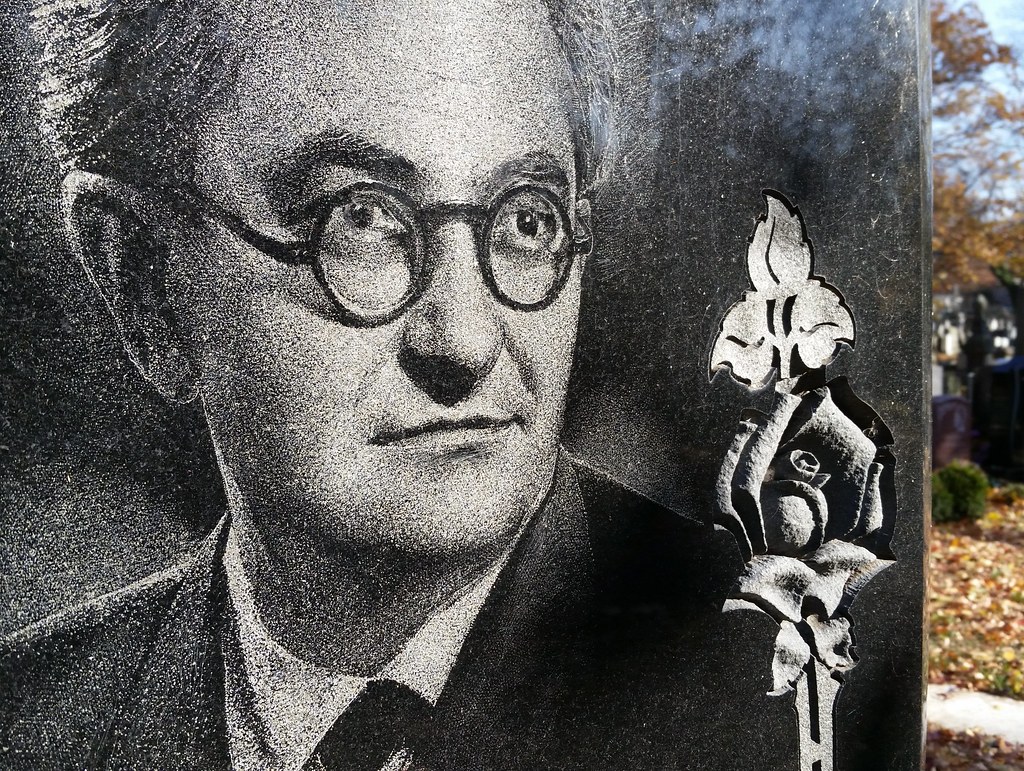
We're now in Beth-El Cemetery (apparently once known as New Union Fields Cemetery), which, like Salem Fields Cemetery, is owned by Temple Emanu-El. It previously belonged to Temple Beth-El, which merged with Emanu-El in 1927.
The headstone above stands in a section of the cemetery largely populated by the laser-etched portrait stones that, as we've seen, are in vogue among Jews from the former Soviet Union.
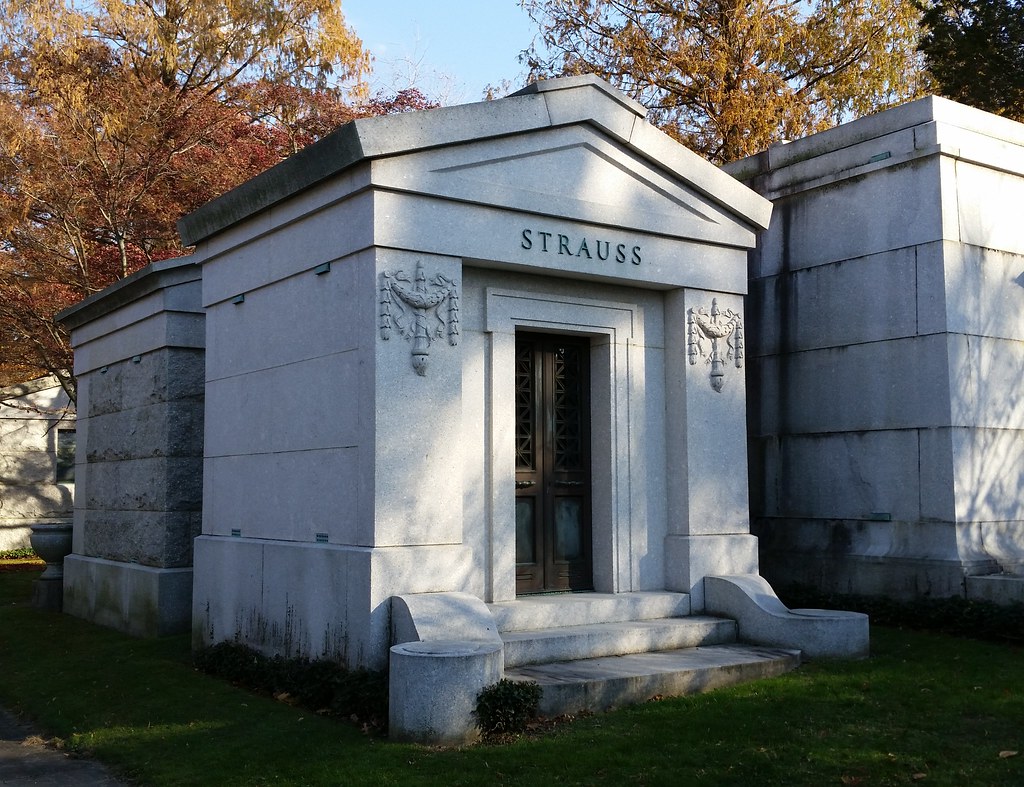
Two of the three Straus brothers, Oscar and Nathan, are buried here in Beth-El Cemetery. I was unable to find them — but I did come across this mausoleum with an extra S. As we've seen, the third brother, Isidor, is buried in an unusual tomb at Woodlawn Cemetery. He famously died aboard the Titanic with his wife Ida: he turned down a place in a lifeboat, seeing that there were still women and children on the ship, and Ida refused to leave his side.
Oscar, who served as Secretary of Commerce and Labor under President Theodore Roosevelt, was the first Jewish member of the US Cabinet. (He wasn't the first Jew to be offered a US Cabinet position, however. President Grant — who, by the way, had ordered the expulsion of all Jews from his military district during his time as a major general in the Civil War — asked Joseph Seligman to be his Secretary of the Treasury, but Seligman declined. And President Cleveland offered Oscar's brother Isidor the job of Postmaster General, then a Cabinet-level post, but Isidor turned him down as well. Oscar was also not the first Jew in America to serve in a Cabinet. That distinction belongs to Judah P. Benjamin, who held three different Confederate Cabinet positions.)
Nathan and Isidor were business partners and very successful merchants who came to own two major New York department stores: Macy's and Abraham & Straus. Nathan was also a noted philanthropist, and his signature cause was "pure milk". He suspected that many of the diseases killing large numbers of young children In the late 19th century were being contracted from contaminated raw milk. Starting in 1893, he and his wife Lina set up milk depots in the city to provide poor families with pasteurized milk at low cost. Their efforts were credited with playing a large role in the precipitous decline of the city's child mortality rate over the following 25 years, during which an estimated 240,000 children's lives were saved.

Joel Goldenberg was one of the original members of Goldenberg Brothers & Co., once one of the country's largest lace importing firms. His nephew Samuel Goldenberg, author of the illustrated Lace: Its Origin and History, was a Titanic survivor whose large canvas bag was reported by the NY Times to be the only piece of luggage saved from the ship and to have somehow never even gotten wet during the whole ordeal. Perhaps worried that people would assume he used his wealth to secure a spot on a lifeboat for his bag instead of another passenger, he wrote a letter to the Times explaining that he didn't save any of his luggage from the Titanic, but that he purchased the bag in question and all its contents once aboard the rescue ship.
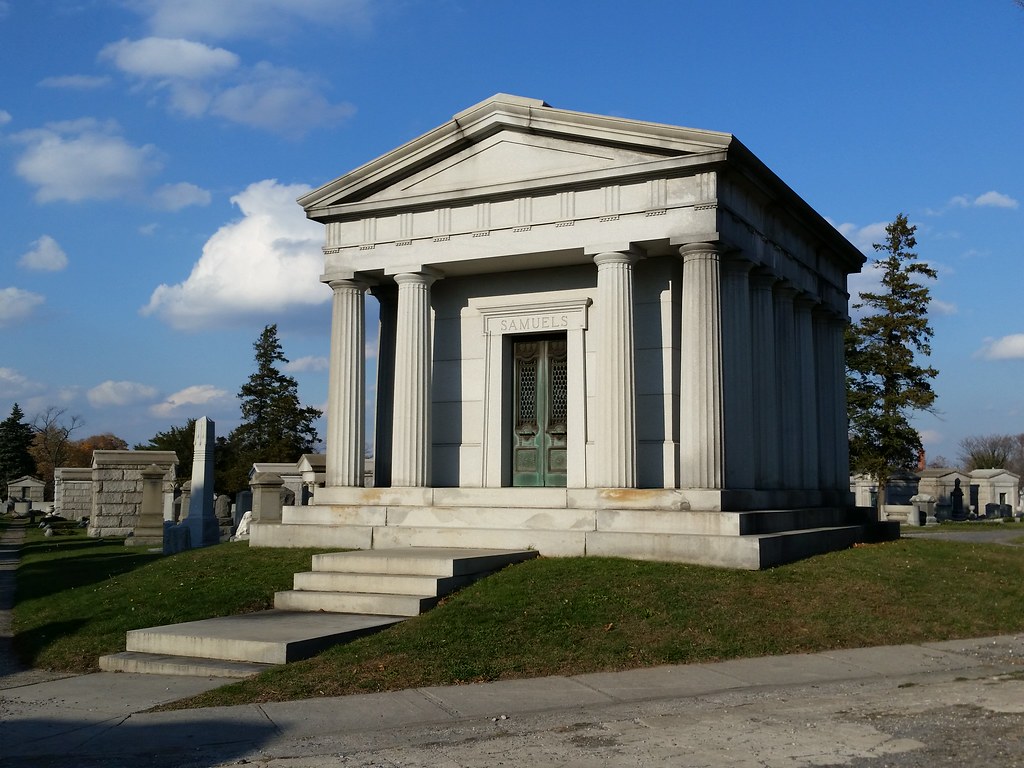
We're now in Mount Neboh Cemetery, the penultimate burial ground on today's tour through seven of the seventeen cemeteries that make up the "great verdant necropolis" spanning the middle of the Brooklyn-Queens border.

From her 1998 NY Times obituary:
Ms. Abzug represented the West Side of Manhattan for three Congressional terms in the 1970's. She brought with her a belligerent, exuberant politics that made her a national character. Often called just Bella, she was recognizable everywhere by her big hats and a voice that Norman Mailer said "could boil the fat off a taxicab driver's neck."(We're now in Old Mount Carmel Cemetery, our final cemetery of the day.)
She opposed the Vietnam War, championed what was then called women's liberation and was one of the first to call for the impeachment of President Richard M. Nixon. Long after it ceased to be fashionable, she called her politics radical. . . .
"There are those who say I'm impatient, impetuous, uppity, rude, profane, brash and overbearing. Whether I'm any of these things or all of them, you can decide for yourself. But whatever I am -- and this ought to be made very clear at the outset -- I am a very serious woman."

Sholem Aleichem, the beloved Yiddish author known as "the Jewish Mark Twain", died on May 13*, 1916. The NY Times estimated that 100,000 people lined the sidewalks of Manhattan's East Side to watch his funeral procession. He was initially buried in neighboring Mount Neboh Cemetery and was later moved to this plot in Old Mount Carmel.
* His date of death is somewhat ironic because, according to his daughter, he had a superstitious aversion to the number 13. She recalled that he "never marks a page [in his manuscripts] with the number 13—it is always 12a." It's been said — even in the NY Times — that his headstone lists his date of death as May 12a, but that is untrue. The dates given on the stone for his birth and death are from the Hebrew calendar.

Saul Yanofsky (or Yanovsky, as his name seems to be spelled everywhere except his tombstone) was apparently "one of the most renowned Jewish anarchists of the day in New York" during the late 1800s and early 1900s. His epitaph reads:
His life was ardently and unselfishly devoted toward establishing human society on principles of no coercion and no exploitation.

In 1913, 13-year-old Mary Phagan from Marietta, Georgia, was murdered at the pencil factory in Atlanta where she worked. The manager of the factory, a Jew from New York named Leo Frank, was put on trial, convicted, and sentenced to death, although it's now generally believed he was innocent. The case and its coverage in the press stoked anti-Semitic sentiment in the area, and when the governor of Georgia commuted Frank's sentence to life in prison in 1915, a mob organized by prominent citizens of Marietta abducted Frank from prison, brought him back to Marietta, and hanged him from a tree. His trial led to the founding of the Anti-Defamation League in 1913 and his lynching helped spark the rebirth of the Ku Klux Klan in 1915.
(The stone above was placed near the entrance of Old Mount Carmel Cemetery, but Frank's grave is located elsewhere in the cemetery.)

